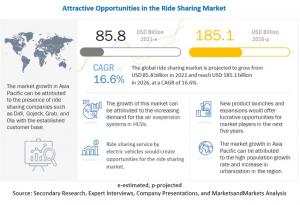

Ride Sharing Market by Type (E-hailing, Station-Based, Car Sharing & Rental), Micro-Mobility (Bicycle, Scooter), Service (Navigation, Payment), & Region
NORTHBROOK, ILLINOIS, UNITED STATES, March 28, 2022 /EINPresswire.com/ — The global Ride Sharing Market is projected to grow at a CAGR of 16.6% during the forecast period, from an estimated $85.8 billion in 2021 to $185.1 billion by 2026.
Ridesharing services were the most preferred services before the pandemic, as they offered a convenient and cost-effective means of personal mobility with the help of a transportation network system. Numerous advantages of ride-sharing services are easy booking options, low carbon footprints, affordable door-to-door ride services and no parking trouble. Decreasing the demand for public transportation to avoid the risk of infection post-Covid-19 pandemic is further promoting the growth of select ride sharing services. Additionally, the introduction of big data analytics, IoT, and AI facilitate smart mobility options and the rise in the availability of cab booking services. With time & need, the mobility service providers (MSPs) devised different models of ride-sharing services such as e-hailing, private vs. corporate car sharing, carpool, car rental and so on. The users had an option to choose from this wide variety of options based on their needs, distance travelled, and personal comfort. However, owing to the pandemic, ride sharing market has become one of the most impacted industries in the automotive space.
Top Players:
Uber, Lyft, DiDi Chuxing, Grab, Ola, GETT, BLABLA CAR, Intel.
Other Regional Players:
Cabify, Car2Go, Taxify.
OPPORTUNITY: Micro-mobility
Micro-mobility describes a variety of vehicles that can accommodate one or two people. Shared micro-mobility is a smart option for anyone seeking to navigate a city quickly and without the problems of mass transit. With traffic congestion rising in many cities and the need for social distancing, there is a growing need for door-to-door mobility options that can address these problems. Shared dockless bikes, e-bikes, and e-scooters are subsidy-free, carbon-neutral, and are more resistant to accidents as they can be used in different lanes.
Increasing demand and affordability are expected to drive the usage of micro-mobility in the coming years. For instance, approximately 50%-60% of all car trips in the US are less than 5 miles, which suggests that micro-mobility has the potential to replace a huge portion of the vehicle miles travelled on the roads each year. Whereas, according to New York’s Department of Transport, the city reported a 67% increase in May 2020 in the usage of New York’s Citi Bike sharing system.
Download PDF Brochure @ https://www.marketsandmarkets.com/pdfdownloadNew.asp?id=198699113
The Asia Pacific is estimated to be the dominant regional market
In the Asia Pacific, developing countries are expected to experience significant growth, primarily in urban transportation. The high population growth rate in the region and increasing urbanization have intensified the need for transportation. Most of the countries in the region are shifting their focus on smart personal mobility to reduce travel time and congestion. The Asia Pacific accounts for a significantly lower number of vehicles per 1,000 persons as the per capita income in most of these countries is lower than in Western countries. Hence, ride sharing offers users a sense of owning a vehicle at a much lower cost than actually owning one. Therefore, consumers prefer ride-sharing services over personal vehicles. Additionally, factors such as a rise in the daily commute to workplaces in urban areas and an increased need to save fuel by providing a ride to commuters and colleagues heading along the same route are anticipated to fuel the Asia Pacific ride-sharing market.
The Electric Vehicle segment is expected to be the fastest-growing segment during the forecast period
In China, according to David Xu, Didi’s head of strategy, a whopping 21% of the ride-hailing fleet is electric. Beijing-based Didi Chuxing Technology Co., the world’s largest ride-hailing company, has about 1 million EVs on its network, with a goal to hit 10 million by 2028.
Moreover, various developments in recent years as, in 2020, Uber announced a new partnership with Lithium Urban Technologies, which is among India’s largest electric vehicle fleet operators. This partnership will deploy over 1,000 electric vehicles for Uber India’s Rentals and Premier services in the upcoming years. Additionally, Uber launched its Uber Green service in London. With this, Uber users in central London can now request a zero-emission vehicle instead of wholly or partly fossil-fueled cars. In January 2021, Uber and in January 2021, expanded the Uber Green service in the USA after launching in 15 US cities in September. Such developments will bring more people toward using ride-sharing with electric vehicles.
The P2P car sharing segment is projected to lead the car-sharing market
P2P car sharing is a type of vehicle sharing in which people share their cars with co-travellers. Also, the P2P model has the owner in the car while the ride is taking place. The demand for P2P car sharing has been on the rise. A car becomes an asset that costs the owner huge money for travelling; one can save money by travelling with co-passengers and sharing the fuel cost or charging the customer accordingly. Major factors driving peer-to-peer car-sharing are convenience and availability, monetary savings, and expanded mobility options.
Request FREE Sample Report @ https://www.marketsandmarkets.com/requestsampleNew.asp?id=198699113
The e-hailing segment by type is expected to hold the largest market share in 2021
the growing demand for e-hailing services can be attributed to ease of booking, increasing traffic congestion, passenger comfort, and rising government initiatives to increase awareness among people regarding air pollution are propelling the demand for ride sharing, predominantly e-hailing. Also, the increasing partnership between domestic and international service providers, such as Uber and Didi in China, is also likely to help the e-hailing market grow.
Mr. Aashish Mehra
MarketsandMarkets INC
INC
+1 888-600-6441
email us here
![]()
The post Global Ride Sharing Market Share, Size, Trends, Analysis, Statistics first appeared on Reality Syndicate Viewers.






